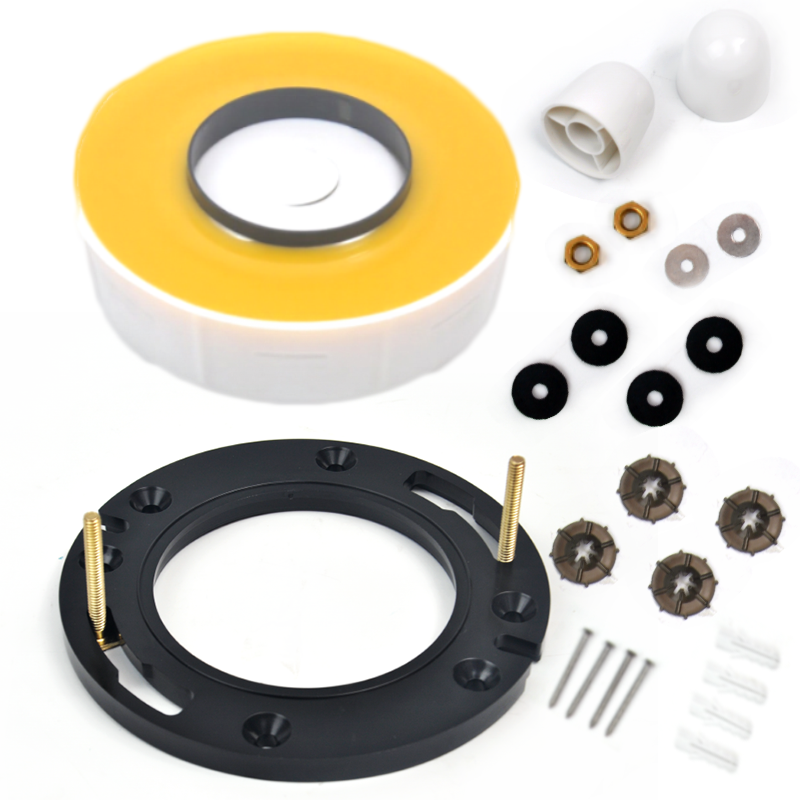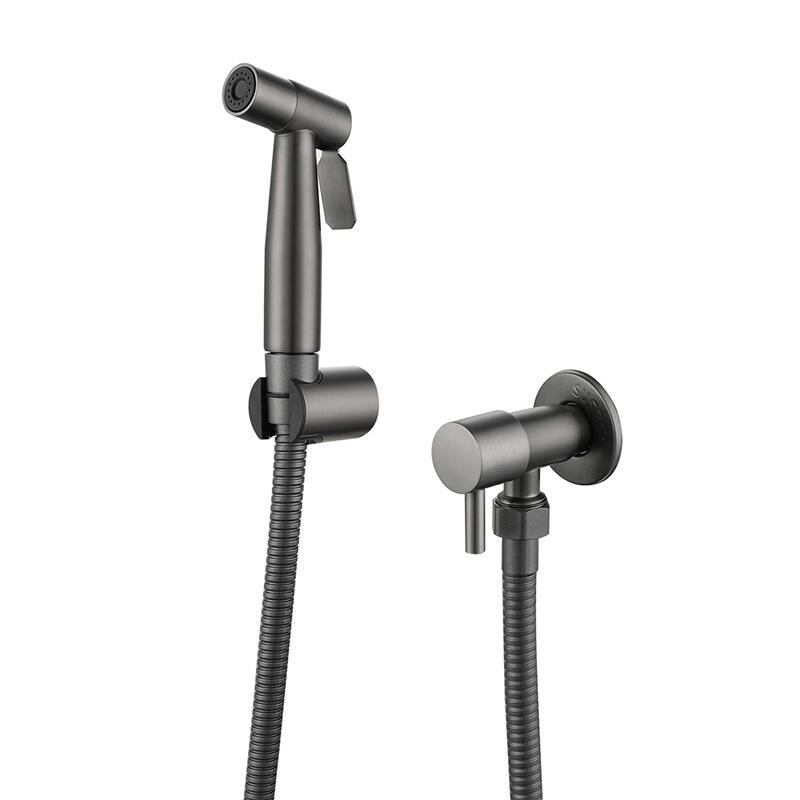What Are Toilet Bolts and Why Are They Critical?
The little-known toilet bolts (sometimes called closet bolts) are what hold the whole thing down, attaching the base of the toilet to both the flange and the actual floor beneath it. These small but important hardware pieces stop all sorts of problems like movement, water escaping, and alignment issues because they keep that critical watertight connection between the toilet bowl and the drain below. When these bolts aren't properly tightened, things start going wrong pretty quickly. The toilet might rock back and forth, which can crack expensive porcelain surfaces or worse yet, pull away completely from that wax ring seal underneath. This creates not just a mess with water damage throughout the bathroom, but also allows nasty sewer gases to escape into living spaces where nobody wants them.
The Function of Closet Bolts and Flange Slots in Secure Installation
The flange slots serve basically as those anchor points where toilet bolts get attached, which keeps the whole toilet sitting securely on top of the plumbing system underneath. Getting everything aligned properly makes sure pressure gets spread out evenly across the connection area. And speaking of bolts, good quality ones stand up much better against those shear forces we all put on them through regular bathroom use day after day. If these bolts are tightened just right, they stop any sideways shifting that might eventually ruin the wax ring seal between the toilet and waste pipe. Most plumbers will tell anyone who asks that using bolts of different sizes or mixed materials can really shorten the lifespan of installations. Some studies show failure happens around 40% faster with mismatched hardware than when everything follows standard specifications from the manufacturer.
Common Problems With Toilet Flanges and Bolts Over Time
Corrosion tops the list of toilet bolt failures, with 68% of water damage cases in bathrooms originating from flange corrosion (Plumbing Standards Institute 2022). Standard steel bolts rust within 2–5 years in humid environments, while plastic variants become brittle and crack. Other issues include:
- Loose bolts causing toilet rocking
- Stripped threads from overtightening
- Flange cracks due to uneven bolt pressure
- Wax ring compression loss from improper installation
Industry surveys show 65% of toilet leaks result from deteriorated bolts, underscoring the importance of material selection and professional installation practices.
Corrosion Resistant Materials Compared: Stainless Steel, Brass, and Plastic
Corrosion and Rust Resistance in Bathroom Environments
The bathroom is basically a breeding ground for metal problems, and studies show around 85% of plumbing issues actually come down to corroded bolts according to the National Plumbing Association report from last year. All that damp air mixed with changing temperatures throughout the day plus those harsh cleaning products really speeds up how fast regular iron or galvanized steel bolts start to rust. For anyone dealing with these conditions regularly, finding materials that won't oxidize so easily becomes pretty important. Most homeowners don't realize just how much stress their bathroom hardware goes through every single day when exposed to all that constant moisture.
Comparison of Stainless Steel, Brass, and Plastic Toilet Bolts
| Property | Stainless Steel | Brass | Plastic |
|---|---|---|---|
| Corrosion Resistance | Exceptional | Moderate | None (cracks instead) |
| Tensile Strength | 700 MPa | 380 MPa | 50 MPa |
| Humidity Tolerance | Unlimited | 15+ years | 3-5 years |
| Chlorine Resistance | Full | Partial degradation | Full |
Stainless steel's chromium oxide layer blocks oxygen diffusion, while brass relies on a copper-zinc patina that weakens in acidic cleaners. Plastic avoids rust but cracks under prolonged stress.
Durability of Stainless Steel Fasteners Under Humidity and Moisture
Stainless steel retains 98% of its tensile strength after decade-long exposure to 80% humidity environments, as verified in accelerated aging tests. Its non-porous surface prevents biofilm formation a key advantage over brass, which develops micro-pitting that traps moisture and bacteria.
Stainless Steel and Brass Components in Toilet Installations: Performance Data
Research on around 1,200 commercial restrooms found that stainless steel bolts only failed about 0.7 times out of every hundred after ten years, while brass had failures at roughly 12%, and plastic was worst with nearly one-third failing. Brass might start off better than regular steel, but when exposed to hard water, it begins losing zinc at three times the normal rate according to Water Quality Association research from last year, which weakens the metal over time. For plastic parts, things get bad fast too. Most installations see cracks forming in under eighteen months if the bolts are subjected to anything over fifty pounds of twisting force. That explains why so many maintenance crews end up replacing these components regularly.
Why Standard Toilet Bolts Fail: The Science of Rust and Corrosion
Rusty Toilet Bolts: Causes and Environmental Triggers
Toilet bolt corrosion mainly comes down to three things: moisture in the environment, contact with oxygen, and those pesky chemical contaminants we often overlook. Most bathrooms sit around 60 to 70 percent humidity, which is basically a recipe for rust when it comes to iron or cheap steel parts. The problem gets worse because common cleaners contain chlorides while tap water usually has sulfates too. These substances speed up the rusting process significantly. A recent study found that steel bolts without protective coatings fail about four times quicker near coastlines where salty air is constantly present. Makes sense why bathroom hardware tends to deteriorate so fast in certain locations.
How Moisture Accelerates Corrosion in Iron and Galvanized Steel Bolts
When moisture gets involved, it starts an electrochemical process where iron basically loses electrons to oxygen, which creates that brittle stuff we know as rust. The zinc layer on galvanized steel does offer some protection initially, though not forever. Problem is those tiny scratches that happen during installation when workers handle the materials can break through this protective barrier. Look at what happens in areas where flanges get flooded regularly. Corrosion just goes through the roof there, maybe tripling what happens in normal dry conditions. And this accelerated decay usually results in bolt heads shearing off completely somewhere between 18 to 24 months after installation depending on how bad the exposure actually is.
Case Study: Failure Analysis of Corroded Toilet Bolt Systems
A 3-year field examination of 120 residential installations revealed:
| Material | Avg. Failure Time | Primary Failure Mode |
|---|---|---|
| Carbon Steel | 11 months | Thread disintegration (84%) |
| Galvanized Steel | 19 months | Neck fracture (63%) |
| Stainless Steel | No failures | N/A (96% integrity retained) |
Systems using plastic-braced wax seals delayed but didn’t prevent metal corrosion, with 68% of bolts requiring replacement despite upgraded gaskets.
Long Term Value: Durability and Cost Benefit of Corrosion Resistant Toilet Bolts
Toilet Bolt Durability and Lifespan: Stainless Steel vs. Brass vs. Coated Steel
Stainless steel toilet bolts outperform brass and coated steel alternatives in humid environments, retaining 98% of their structural integrity after 10 years according to fastener research. Brass offers moderate corrosion resistance but weakens when exposed to hard water minerals, while coated steel bolts frequently fail within 5–7 years due to coating degradation.
Field Data on Corrosion Resistant Bolt Performance Over 10+ Years
A 12-year plumbing study found 89% of stainless steel toilet bolts required zero maintenance in residential bathrooms, compared to 34% of brass and 9% of epoxy-coated steel variants. Stainless fasteners showed no thread erosion even in coastal regions with salt-heavy air, a critical advantage documented in industrial fastener analysis.
Industry Paradox: High Initial Cost vs. Long Term Savings in Maintenance
Though stainless steel bolts cost 3–5 times more upfront than standard models, they reduce lifetime ownership costs by 62% by eliminating repeated replacements. For commercial buildings, this translates to $1,200+ savings per toilet fixture over 15 years–a ROI pattern mirrored in corrosion economics research.
Hidden Costs of Replacing Toilet Bolts Due to Corrosion
Rusted bolt removal often requires flange repairs averaging $285–$420 per incident (2024 plumbing labor rates). Secondary water damage from slow leaks accounts for 37% of corrosion related insurance claims in multi-unit housing a preventable cost with proper material selection.
Best Practices for Installing and Maintaining Long Lasting Toilet Bolts
Proper Sealing and Moisture Barriers During Toilet Installation
Getting good seals starts when someone applies that silicone caulk all around where the toilet meets the floor, but remember to leave about an inch open at the rear so any leaks can be spotted early on. Most plumbers will tell anyone who asks that keeping those flange slots clean is absolutely essential, plus they always recommend those compression washers to keep everything lined up properly vertically, especially important for those stainless steel or brass bolts we commonly see these days. When folks switch over to wax-free rings along with materials that won't corrode easily, something interesting happens – studies show this combo cuts down on potential leaks by roughly two thirds compared with old school methods. Not bad for a simple upgrade really.
Preventing and Addressing Rust and Corrosion at the Flange Level
In humid climates, stainless steel bolts generally last much longer than their coated steel counterparts. Tests over five-year periods show around 12% surface oxidation on stainless compared to nearly complete degradation in other materials. When dealing with old rust spots, grab a stiff wire brush first to clear away all loose particles. Then slap on some good quality zinc-rich primer before putting everything back together. Don't forget to check those flanges and bolts at least once a year though. A quick visual inspection can catch early signs of corrosion that might otherwise lead to catastrophic failure down the road when nobody expects it.
When Do Standard Bolts Fail? Average Replacement Intervals by Material
| Material | Average Lifespan | Failure Mode | Replacement Cost* |
|---|---|---|---|
| Stainless Steel | 15+ years | Thread wear (not corrosion) | $8–$12 |
| Brass | 8–12 years | Stress fractures | $10–$15 |
| Coated Steel | 3–5 years | Complete rust-through | $5–$8 |
*Costs reflect 2024 national averages for bolt kits and labor. Stainless steel's upfront cost is offset by a 79% reduction in repeat service calls over a 10-year period.




